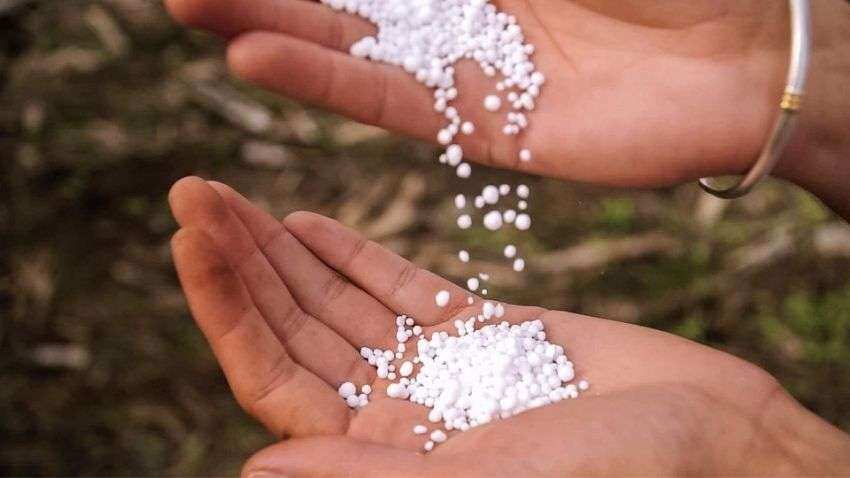Fertiliser subsidy set to touch record Rs 1.65 lakh cr in FY23: Report
The fertiliser subsidy is likely to touch an all-time high of Rs 1.65 lakh crore this financial year against the budget estimate of Rs 1.05 lakh crore due to an unprecedented rise in the cost of raw materials and fertilisers globally, according to a report.

The fertiliser subsidy is likely to touch an all-time high of Rs 1.65 lakh crore this financial year against the budget estimate of Rs 1.05 lakh crore due to an unprecedented rise in the cost of raw materials and fertilisers globally, according to a report.
India's fertiliser subsidy is set to touch a record of Rs 1.65 lakh crore and an additional subsidy and revision in the nutrient-based subsidy (NBS) rates are crucial in order to sustain the credit profiles of fertiliser makers, Crisil said in a report.
See Zee Business Live TV Streaming Below:
"Our assessment assumes 3 per cent year-on-year growth in demand for fertilisers and a moderation of raw material and fertiliser prices in the second half of this fiscal. If demand is higher than expected, or input prices do not soften even in the second half, the subsidy bill may inch up to Rs 1.8-1.9 lakh crore," the report added.
According to the report, in the past two fiscals, the government has paid an additional Rs 1.2 lakh crore and increased the budgeted subsidy.
However, the steep rise in raw material prices has been negating this and another intervention may be needed in 2022-23, the Crisil report noted.
"Over 85 per cent of the subsidy arrears could be contributed by urea. This is because pooled gas prices - a blend of domestic gas and imported LNG considered for billing to fertilisers plants - had shot up more than 75 per cent last fiscal, and is expected to remain elevated for most part of 2022-23, because of the Russia-Ukraine conflict," Crisil Ratings director Nitesh Jain said.
At the same time, retail prices of urea have stayed put, increasing the government's subsidy burden, he noted.
"This would be despite some respite likely from the commissioning of new domestic capacities that could potentially halve India's import dependence for urea from nearly 28 per cent in fiscal 2021," he added.
The retail selling price (RSP) of urea is fixed by the government, the report explained.
To spur farmers to use fertilisers for better crop yield, the government keeps the RSP significantly lower than the market rate, and reimburses the urea makers through subsidy payments, it said.
While this protects the profitability of urea makers to a large extent, the RSP remaining unchanged despite rising costs will mean the government will have to foot a bigger subsidy bill, it added.
Likewise, prices of phosphoric acid and rock phosphate - ingredients for non-urea fertilisers - have also gone up by 92 per cent and 99 per cent, respectively, in the past 12 months through March 2022.
Further, given that Russia, Belarus and Ukraine are the major suppliers of non-urea fertiliser ingredients, the ongoing conflict will only exacerbate the situation, it stated. While non-urea makers have hiked prices, it may not be sufficient to cover the escalation in cost, Crisil said.
For non-urea fertiliser makers, the government pays subsidy as per the nutrient-based subsidy (NBS) rates, which are yet to be announced for this fiscal.
In this backdrop, the credit profiles of fertiliser makers will depend on factors like additional subsidy outlay, mainly for urea makers, and revision of NBS rates for non-urea makers.
Any delay in, or inadequacy of, subsidy payments can have a bearing on the cash flows of fertiliser makers, and lead to higher working capital needs, the report added.
Get Latest Business News, Stock Market Updates and Videos; Check your tax outgo through Income Tax Calculator and save money through our Personal Finance coverage. Check Business Breaking News Live on Zee Business Twitter and Facebook. Subscribe on YouTube.
RECOMMENDED STORIES

Senior Citizen Latest FD Rates: Know what major banks like SBI, PNB, Canara Bank, HDFC Bank, ICICI Bank are providing on fixed deposits

Gratuity Calculator: Rs 38,000 as last-drawn basic salary, 5 years and 5 months of service; what will be gratuity amount?

Retirement Planning: In how many years your Rs 25K monthly SIP investment will grow to Rs 8.8 cr | See calculations

Top 5 Small Cap Mutual Funds with best SIP returns in 1 year: See how Rs 25,000 monthly investment has grown in each scheme

Top 7 SBI Mutual Funds With Best SIP Returns in 1 Year: Rs 25,000 monthly SIP investment in No.1 fund has jumped to Rs 3,58,404

SBI 5-Year FD vs MIS: Which can offer higher returns on a Rs 2,00,000 investment over 5 years? See calculations
05:25 PM IST










 Soil degradation on 30% of India's land poses threat to agriculture: Agri minister
Soil degradation on 30% of India's land poses threat to agriculture: Agri minister Agriculture ministry to host seed sector summit in Varanasi from Nov 28-30
Agriculture ministry to host seed sector summit in Varanasi from Nov 28-30 Kharif crop sowing crosses 979 lakh hectare mark; catch key takeaways from latest official data
Kharif crop sowing crosses 979 lakh hectare mark; catch key takeaways from latest official data 86% of Jharkhand's arable land for paddy cultivation lying fallow due to scanty rainfall
86% of Jharkhand's arable land for paddy cultivation lying fallow due to scanty rainfall Gujarat to give 50% subsidy to farmers on Nano Urea and Nano DAP
Gujarat to give 50% subsidy to farmers on Nano Urea and Nano DAP